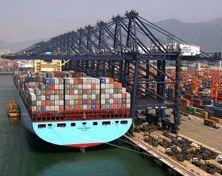
To management and staff operating ports up and down the West Coast of the US, it must seem like just yesterday that international trade was booming, with cargo flowing through their docks at break-neck speed. As recently as 2007, ports from San Diego to Vancouver, British Columbia, were trying to figure out how they would accommodate the trade anticipated over the next decade, with their cargo infrastructure already stretched to the limit.
Like a fast-ebbing tide, the level of international trade has receded precipitously over the last year, driven by the deepening global recession. A sample of the level of commerce for California’s major ports measured in twenty foot container units (TEUs) is revealing: in 2009, the Port of Los Angeles saw its cargo volume decline by 7.1 per cent to 7.8m TEUs in 2008. Through February of this year, TEUs volumes were down by nearly 21 per cent. Long Beach has fared even worse, with TEU volumes dipping by over 11 per cent for 2008 and down by 40 per cent so far this year. In northern California, the port of Oakland has seen volumes slip by 6.4 per cent for 2008 and 21 per cent so far this year.
The results have been mixed in the Pacific Northwest. The port of Seattle had a difficult 2008, witnessing TEU traffic fall by 13.6 per cent. Tacoma posted the best numbers of all major US West Coast ports with a mere 3.3 per cent reduction in TEUs. Only Vancouver, British Columbia, managed to end 2008 on a relatively positive note, as its container volumes were virtually unchanged from the year before at 2.5m TEUs.
In an attempt to stem the tide of lost trade, both Long Beach and Los Angeles ports are reportedly reducing entry fees by 10 per cent for containers crossing their docks. If, as expected, international trade doesn’t improve anytime soon, projects that West Coast ports have been planning for 2009 and beyond may have to be postponed indefinitely. Among the most vulnerable is Los Angeles and Long Beach ports’ “Clean Truck Program”, a US$44m program designed to reduce truck emissions by 80 per cent by 2012. The recession’s impact is already being felt in Oakland as the port has laid off 12 per cent of its staff and cancelled free tours for the public.
Steamship lines servicing the export trade between the US West Coast and Asia have also reacted to the slackening global economy, canceling a scheduled general rate increase for this spring on various produce categories, and they are now reportedly reducing their rates.
If there is a bright spot for the western US maritime trade, it would be appear to be its imports and exports of fresh produce. According to Lori Kelman of the Port of Los Angeles, shipments of fruits and vegetables have been a growth sector for the port.
“The metric tonnage of produce at the Port of LA has grown from 843,705 tonnes in 2004 to 1,079,821 tonnes as of 2008,” says Ms Kelman. “The increase in metric tonnage in perishables has gone to the reefer container business at the expense of break-bulk. There was a remarkable increase in exports of oranges in 2008 (up 145 per cent) as NYKCool stopped its service from Port Hueneme to Japan for California citrus, with this trade taken over by containerized shipments from the ports of LA and Long Beach.”
Imports of produce continue to be a plus for US East Coast ports as well. “This cargo niche has been growing by about 3 per cent over the past five years,” says Vered Nohi-Becker, marketing services manager for the Port of Wilmington, Delaware. “Fruit imports have remained strong and market demand is very steady. A strengthening US dollar has brought more cargo to the US East Coast. The assumption is that in difficult financial times, consumers tend to dine and host at home and therefore consume more produce.”



